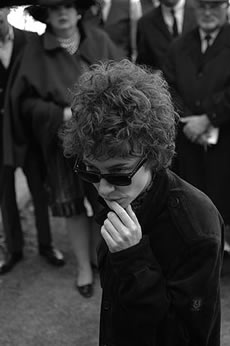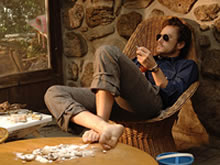
Todd's Not There
By Karin Badt
I'm Not There
A film directed by Todd Haynes
Screenplay by Todd Haynes and Oren Moverman
Various Cinemas
I'm Not There is glossy and slick:
a tribute to Bob Dylan's own slickness in constructing his celebrity
identities out of a pastiche of Americana narratives. Todd Haynes's
experiment in this compellingly narcotic film reminded me of the
semiotics class we took together at Brown, on "Parody and Pastiche."
Back then, we discussed Baudrillard and Lyotard, and enthused
about postmodern concepts of identity as "construction." The key
film for the course was Orson Welles's F for Fake: "which
is real? which is fake?" the voice-over asked while the camera
zoomed in on a dubious (or was it?) Picasso.
How inspiring this class must have been,
I thought, to have its precepts executed so exactly in a two-hour
plus film, twenty years later. I remembered Todd as the earnest,
red-haired student perched forward in his chair, with taut intensity,
bright eyes and upraised, nodding chin: the most memorable person
in the class. His student film at the time--using Barbie Dolls
to reconstruct the Karen Carpenter story (another victim of identity
fashioning)--was a creative plunge into the decomposition of traditional
narrative, a technique we had all been taught.
Now he had taken his interest in American
self-fashioning in the celebrity world to another level.
Or had he? Our amateur devotion to postmodernism
was exciting at the time, but aren't these times achanging? Quite
frankly, despite the intrigue, I was bored. Yes, Dylan is not
there, but this one-liner did not get me very far. Was there a
political or cultural or even philosophical subtext to the not-there-ness--or
just a lot of fun with narrative tricks? The narrative tricks
were loud and clear: sets that groaned with their own fabrication
(fake Western streets, Americana railroad rides); forced shifts
from black-and-white to color; the lead singer played by several
different actors (pace Luis Buñuel who did the same thirty years
ago in That Obscure Object of Desire, and Todd Solondz
who revived the trick more meaningfully five years ago in Palindromes).
One trick is Haynes's unique trademark: actors who perform like
mannered dolls, in costumes and exaggerated hand-gestures, in
playful parody of the l960s.
The thing is, the theorists who so influenced
Haynes--Baudrillard and Lyotard--connected their analysis of the
commercial proliferation of images to a critique of capitalism
and use value. Haynes connects his playful deconstruction of Dylan
to nothing, absolutely nothing. Nor does he develop, as did his
predecessors in postmodernism, such as Nabokov and Pynchon, a
thought-provoking aesthetics, with truly new considerations of
character, time and place. While the set-up of Haynes' narrative
is surely inventive, it doesn't lead to any new vision. The only
pleasure or interest I took in the film was in Cate Blanchett's
superb and gorgeous performance as one of Dylan's alter-egos,
and of course in the (too few) songs. The pastiche idea seemed
as if it had been on the backburner too long, standing still while
America moved on.
 I
asked Todd about his semiotic influence at the press conference
in Venice, and he responded with enthusiasm for how important
Bob Dylan was as an icon. Yet the film places no value on this
importance, and offers no insight into it. We have Americana clichés
about family, glamour, travelling, success--and at the end Bob
Dylan's own lips on the harmonica, which remind us that, contrary
to the film's message, an expressive artist is there.
I
asked Todd about his semiotic influence at the press conference
in Venice, and he responded with enthusiasm for how important
Bob Dylan was as an icon. Yet the film places no value on this
importance, and offers no insight into it. We have Americana clichés
about family, glamour, travelling, success--and at the end Bob
Dylan's own lips on the harmonica, which remind us that, contrary
to the film's message, an expressive artist is there.
My companion at the screening, a fellow
journalist, clapped furiously at the film's finish. "Genius, pure
genius!" he exclaimed. Why? "Because Bob Dylan was all construction,
and this film shows he was all construction." "Is there anything
more to Dylan than that?" I responded, unconvinced by the payoff.
"No," my companion said. "He was a huckster."
Take away this idea of the huckster--this
depoliticized echo of theories bandied loosely on a college campus--and
it's hard to see what this film offers except a series of glamour
shots and insular concepts about what it means to be American,
as well as reductions of the1960s (war included) to "image"? This
emptiness is unfortunate, partly because there's more to Dylan
than that,* but also because Haynes's previous films--such as
Safe and Far From Heaven--used postmodern ideas
to much better effect. Those films gave their subjects worth and
poignancy, and had impressive aesthetics beyond their self-referentiality.
-----------------------------
*In a recent interview on the Huffington
Post, Haynes notes that "of course [he] could have asked
to meet with or talk to Bob Dylan," but he "never needed to do
so to make the film." For Dylan fans who find Haynes's film a
profound, fresh look at their hero, this fact should be revealing.
Is Dylan not there, or does Todd not want him to be there?
